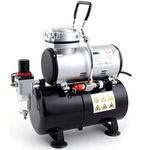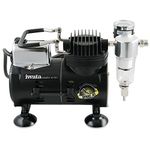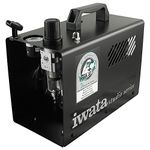10 bestAirbrush Compressorsof December 2025
112M consumers helped this year.
1
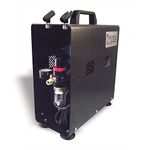
Badger Air-Brush Co. TC910 Aspire Pro Compressor,Black
Masino

10.0
2
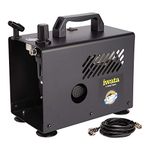
Iwata-Medea Studio Series Smart Jet Pro Single Piston Air Compressor
Iwata

10.0
3
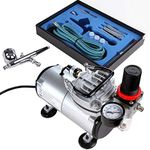
Timbertech Airbrush Compressor Kit ABPST05, Single Piston Quiet 1/6hp Compressor, Multi-purpose Gravity Feed Airbrush Kit with Airbrush Gun, Hose for Airbrush Paint, Nails, Tattoo,Makeup,Cake Painting
TIMBERTECH

9.9
8% off
4

Timbertech Professional Upgraded Piston Airbrush Compressor with Motor Cool Down Fan ABPST08, Max 57PSI, Quiet Airbrush Compressor with Tank for Airbrush Paint, Nails, Tattoo, Makeup, Cake Painting
TIMBERTECH

9.8
5
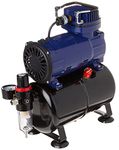
Paasche D3000R 1/5 HP Compressor with Tank, Regulator and Moisture Trap
Paasche

9.6
OtherUp to 8% off
6

Oil-Free Silent Compressor Sparmax TC-620X
Sparmax

9.4
12% off
7
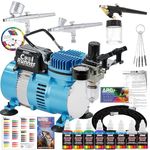
Professional 3 Airbrush System Kit with G22, G25, E91 Master Airbrushes & TC-20 Air Compressor, 6 Primary Colors US Art Supply Paint Set, Color Mixing Wheel, Guide Booklet & Chart
Master Airbrush

9.2
8
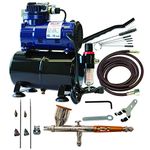
Paasche Airbrush TG-300R Double Action Gravity Feed Airbrush Set and Compressor with Tank, None
Paasche

9.0
9
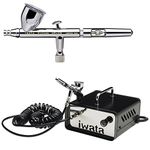
Eclipse HP-CS 4207 Airbrush Kit with Iwata Ninja Jet Compressor & Air Hose
Iwata

8.8
10
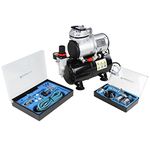
TIMBERTECH Airbrush Compressor Kit ABPST06, Powerful 1/6 HP Airbrush Compressor with Tank and 2 Airbrush Gun Kits for Airbrush Painting, Makeup, Nail and Tattoo studios, Hobby
TIMBERTECH

8.6
A Guide to Selecting the Best Airbrush Compressors
Choosing the right airbrush compressor is essential for getting the best results from your airbrushing projects, whether you're into model painting, cake decorating, makeup, or fine art. The compressor is the heart of your airbrush setup, providing the airflow needed to spray paint smoothly and consistently. When picking a compressor, it's important to consider how and where you'll use it, as well as the type of airbrushing you plan to do. Understanding the key specifications will help you find a compressor that matches your needs and ensures a pleasant, reliable airbrushing experience.
Air Pressure (PSI)
Air pressure, measured in PSI (pounds per square inch), determines how much force the compressor can deliver to push paint through the airbrush. Higher PSI allows for spraying thicker paints and covering larger areas, while lower PSI is better for fine detail work. Compressors typically range from around 10 to 60 PSI. For most hobby and art uses, 15-30 PSI is sufficient, while makeup or cake decorating often requires lower pressures (10-20 PSI). If you plan to do a variety of projects, look for a compressor with adjustable PSI so you can tailor the pressure to your needs.
Airflow (CFM or LPM)
Airflow, measured in CFM (cubic feet per minute) or LPM (liters per minute), tells you how much air the compressor can deliver. More airflow means the compressor can keep up with longer or more demanding spraying sessions without losing pressure. For small, detailed work, lower airflow is fine, but for larger surfaces or continuous use, higher airflow is better. Typical values range from 10 to 30 LPM. Consider what you'll be painting: if you need to cover big areas or use larger airbrushes, choose a compressor with higher airflow.
Tank or Tankless
Some compressors have an air tank, while others are tankless. A tank stores compressed air, allowing for smoother, more consistent airflow and reducing the need for the compressor motor to run constantly. This can make the compressor quieter and extend its lifespan. Tankless compressors are smaller and lighter, making them more portable, but they may pulse or overheat during long sessions. If you value portability and only work for short periods, tankless may be fine. For longer or more consistent work, a compressor with a tank is usually better.
Noise Level
Noise level is how loud the compressor is when running, usually measured in decibels (dB). Quieter compressors are more comfortable to use, especially indoors or in shared spaces. Noise levels can range from around 40 dB (quiet conversation) to over 60 dB (loud). If you need to work in a quiet environment or for long periods, look for a compressor with a lower noise rating.
Moisture Trap
A moisture trap is a feature that removes water from the compressed air before it reaches your airbrush. Moisture can cause paint to splatter or ruin your work, especially in humid environments. Some compressors come with built-in moisture traps, while others require you to add one separately. If you live in a humid area or want to avoid paint issues, make sure your compressor setup includes a moisture trap.
Auto-Stop/Auto-Start
Auto-stop or auto-start is a feature where the compressor automatically turns off when the desired pressure is reached and restarts when more air is needed. This helps reduce noise, saves energy, and extends the life of the compressor. If you plan to use your airbrush for extended periods or want a more convenient experience, look for a compressor with this feature.
Portability and Size
Portability and size refer to how easy it is to move and store the compressor. Smaller, lighter compressors are easier to carry and store, making them ideal for travel or limited workspace. Larger compressors with tanks are heavier but offer more consistent performance. Think about where you'll use your compressor and how often you'll need to move it to decide which size is best for you.
Best Reviews Guide Newsletter
Get exclusive articles, recommendations, shopping tips, and sales alerts
Sign up for our newsletter to receive weekly recommendations about seasonal and trendy products
Thank you for subscribing!
By submitting your email address you agree to our Terms and Conditions and Privacy Policy
